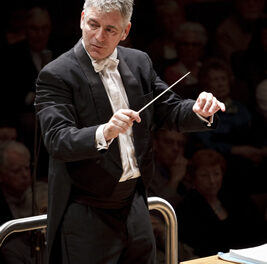Founded in 1941, the Raleigh Chamber Music Guild under Edgar Alden’s pioneering direction featured various local and regional musicians through 1948. In 1949, the Juilliard String Quartet, the first of a steady stream of nationally and internationally acclaimed ensembles, appeared on the series. It was truly fitting that, on April 7, at the last concert of the Sixtieth season, violinist Robert Mann, last of the founding members of that quartet, was on hand in Fletcher Opera Theater. Despite the madhouse of traffic conditions, a hit opera next door in Memorial Auditorium Hall, a Raleigh road race that involved closed streets and parking woes, the event drew the largest crowd to date for the RCMG’s Masters Series. From my side balcony seat, I could watch Mann’s close attention to the performances in the first half of the concert. On stage was the excellent Mendelssohn String Quartet, which is in residence at the North Carolina School of the Arts. Led by noted virtuoso Miriam Fried, the second violinist was Nicholas Mann, Robert’s son, carrying on the chamber music tradition into a new generation. Urich Eichenauer was the violist and Marcy Rosen was the cellist. After intermission, Robert Mann joined the quartet for a rare outing as second violist.
Mozart’s Quartet in D, K.575, the first of the last three “Prussian” Quartets, opened the concert. The ensemble played in front of the closed curtain, forward of the proscenium, but I felt that the large extent of material seemed to reduce the expected volume of sound, but the ears eventually adjusted. I suppose this was better than playing from a location deeper within the stage with all the sound free to go up through the rafters and side wings. An acoustical shell is needed for chamber music and recitals.
The interpretation was stylish with impeccable intonation and phrasing. Leader Fried is a very animated and physical performer, rather like Geoff Nuttall of the St. Lawrence String Quartet. She doesn’t stamp her feet but constantly twists and sways her upper torso. A colleague noted that Nicolas Mann was also animated but I hardly noticed it at the time. Mozart quartets reveal the slightest imperfections and this critic heard none.
Cellist Rosen gave a short impassioned plea for the audience members to open their perceptions, close their eyes to the players and immerse themselves in the color and timbres of Henri Dutilleux’s String Quartet, “Ansi la nuit” (“Thus the night”). The great living French composer completed the score in 1976 for the Juilliard String Quartet. I have regarded this, along with the Lutoslawski, to be among the greatest quartets from the last half of the Twentieth Century. It should join the repertory along with the Bartok’s six, Shostakovich’s fifteen and, in direct lineage, those of Debussy and Ravel. Like the later, Dutilleux’s quartet is carefully structured with extraordinary attention to color. I like to think of it as a constantly changing Chihuly-like sonic sculpture or mobile. All these qualities were brought out superbly by the Mendelssohn Quartet players in each of the seven brief sections. Shortly after its commission, it was played on the Durham Chamber Arts Series by the Juilliard with Robert Mann in the first chair and it has been played here at least once since then.
Quintets for strings are too seldom heard, so the programming of Mendelssohn’s Second String Quintet in B-Flat, Op. 87, was a treat worthy of the RCMG’s celebration. Rare even on recordings, this was probably only the second time that I had heard a live performance, the first being a Spoleto USA concert in the 1980s. Fried’s animated dervish made the first movement seem much more violin dominated than I had remembered. While not as elfin as the scherzos of the Octet or the Midsummer Night’s Dream, the second movement brought a more even distribution of parts. One could savor the wonderful blending of Mann’s viola with Eichenauer’s. The pizzicatos were lovely. The “Adagio e lento” was appropriately slow and somber. The beautifully matched duet of the violins against a rhythmic figure in the lower strings was marvelous. Fast tempos characterized the fleet last movement. A tune by the burnished violas was countered by the violins. Rosen’s firm cello sound was a fine anchor.
Enthusiastic applause brought several curtain calls and a lovely bouquet of lilies was presented to Robert Mann. The program notes and the Guild’s president revealed that this was the nineteenth time that he had appeared under Guild sponsorship. There are at least three Mozart quintets that are not over exposed. Bring back Mann and the Mendelssohn Quartet to delight us again!
Looking over the state, besides the two separate chamber music series in the Triangle, there seems to be only one more small series devoted exclusively to chamber music- – in Pinehurst. Triangle music lovers are unbelievably lucky to be able to attend two extensive series so close by. We all owe a great debt to Edgar and Dorothy Alden for their efforts in founding the RCMG and to Ernest W. Nelson, who established the Durham Chamber Arts Society two years later.











